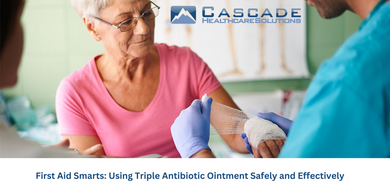The largest organ in the human body is our skin. It covers your entire body as a barrier between the inside and outside world.
Working in senior care, I have seen some really bad skin conditions that can lead to more serious health issues for the patient.
Using proper topicals can help keep minor skin issues from turning into major issues. That is why I like a good triple antibiotic ointment.
Triple antibiotic ointment is a common household item and topical medication to prevent infections in minor skin wounds like cuts, scrapes, and burns. It's readily available over-the-counter and generally considered safe for most people. However, there's more to this ointment than meets the eye.
What's in the Mix?
As the name suggests, triple antibiotic ointment combines three antibiotics:
- Bacitracin:This antibiotic fights against a broad range of gram-positive bacteria, commonly found on the skin.
- Neomycin:Similar to bacitracin, neomycin targets a wide spectrum of gram-positive and some gram-negative bacteria.
- Polymyxin B:This one tackles gram-negative bacteria, another type commonly linked to infections.
By combining these three antibiotics, the ointment offers broader protection against potential bacterial infections in minor wounds.
Here is an example of Triple Antibiotic Ointment
For those that need pain relief as well
When to Use and When to Not Use
While triple antibiotic ointment is a handy first-aid item, it's not a cure-all. Here's when it's appropriate to use it:
- Minor cuts, scrapes, and burns:Apply a thin layer to clean and dry wounds to help prevent infection.
- Prevention of infection after minor procedures:Like shaving nicks or minor insect bites.
However, there are instances where it's not recommended:
- Deep wounds, puncture wounds, or animal bites:These require medical attention and may need stronger antibiotics.
- Large areas of skin:Using it on extensive areas can increase the risk of side effects.
- Allergy to any ingredients:Check the label for ingredients and consult a doctor if unsure.
- Signs of worsening infection:If the redness, swelling, or pain worsens, seek medical help.
Remember:
- Clean the wound thoroughly with soap and water before applying the ointment.
- Follow the instructions on the label for proper application and dosage.
- Don't overuse the ointment, as it can contribute to antibiotic resistance.
- Consult a doctor if the wound worsens or doesn't improve after a few days of use.
Alternatives to Consider:
While triple antibiotic ointment is a popular choice, other options exist, including:
- Bacitracin ointment:Suitable for those allergic to neomycin or polymyxin B.
- Silver sulfadiazine cream:Effective against a broader range of bacteria, but may stain clothes.
The Final Word:
Triple antibiotic ointment can be a valuable addition to your first-aid kit, but it's crucial touse it wisely. Remember, it's not a replacement for proper wound care and seeking medical attention when needed. By understanding its uses and limitations, you can ensure this ointment serves its purpose effectively.
Please consult your Primary physician before using any product.

 Help
Help 



